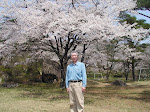My haiku appeared on the Asahi Haikuist Network by David McMurray on September 4.
Diving in
the coral reef—
fish
Professor David McMurray at the International University of Kagoshima in Japan, who is a columnist for this Network, noted as follows:
Akita-based haikuist Hidenori Hiruta enjoys scuba diving the Great Barrier Reef in Cairns, Australia. By taking the plunge he opens up a whole new world for his readers to imagine.
I wonder how my readers have imagined of the world of my haiku.
What images do they have in it?
What I imagined after scuba diving was that I was watching fish paradise or fish kingdom.
That is because myriads of tropical fish are enjoying swimming around the coral reef, inside or outside of it.
At that time I was reminded of the legend of Urashima Taro(浦島太郎), which is a Japanese legend about a fisherman who rescues a turtle and is rewarded for this with a visit to the Palace of the Dragon God (or Ryugu-joh) under the sea. He stays there for three days and, upon his return to his village, finds himself three hundred years in the future. The tale has been identified as the earliest example of a story involving time travel.
The name of Urashima Taro first appears in the 15th century (the Muromachi Period), in the book Otogizoshi, but the story is much older, dating back to the 8th century ( the Nara Period).
Now I imagine that one young man in the ancient days happened to dive in a coral reef around the sea near the beach in Japan, and found the beautiful coral reef with various fish swimming around.
Maybe he thought as if he were living in fish palace , and that legend of Urashima Taro got popular among the people, with some changes added to by some storytellers in those days.
― Hidenori Hiruta


